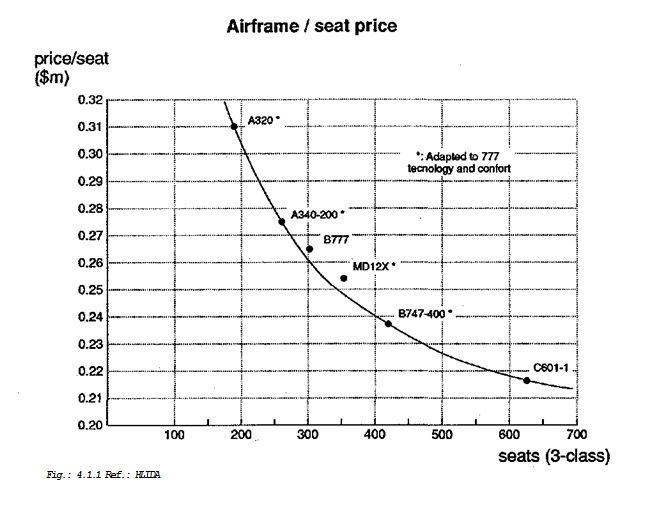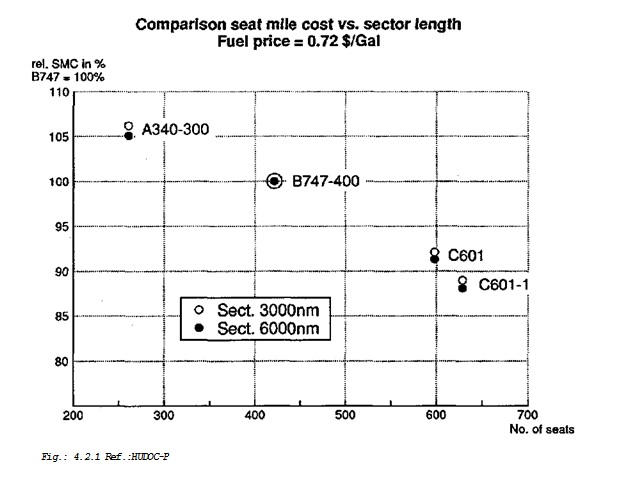PRICE EVALUATION
The price of the aircraft is a very important factor to the operating costs. For the evaluation of an approximate aircraft price we have to find the airframe price by estimating the airframe price per seat and the price of the power plants.
The tendency is that the price decreases with increasing number of seats and increases with range and technology standard. The decrease with number of seats gets less effective at a certain point of size.
To get the price of the airframe per seat, the prices (according to DA) of other aircraft airframes were first adapted to the C601 standard. Then a curve was drawn with the expected trend.
Table 4.1: Airframe price/passenger [$m/pass]
|
Type |
Actual price per passenger | Correction factor | adapted price |
Passenger |
|
A320 |
0.302 |
1.026 (Range) |
0.31 |
189 |
|
A340-300 |
0.268 |
1.025 (Old burden) |
0.275 |
261 |
|
111 |
0.265 |
1.0 (newest tech.) |
0.265 |
302 |
|
MD12X |
0.245 |
1.035 (Old burden and fuel burn) |
0.254 |
354 |
|
747-400 |
0.226 |
1.05 (fuel .burn) |
0.237 |
421 |
Fig.: 4.1.1 Ref.: HLIDA
From the curve we can take with 629 passengers a price per passenger of US$ 217 000.
The whole airframe would than cost US$ 136 M.
Engine price
The GE90 is on offer, with a sea level static thrust of 374 kN, for US$ 11.6 M.
The price is assumed to be a function of (thrust ratio)0‘8.
If the C601 needs a slst of 342 kN the price would be US$ 10.8 M each.
The price of the whole aircraft is then given as: C601 price: US$ 179 M.
“A realistic price for such a performer (600 seats) would be US$ 180-200 M”, Korean Air Lines.
4.2 OPERATING COST
The program to evaluate direct operating cost was made by AI in 1979 and was updated in 1988 (AI/TD-046/, 1988). In order that valid consistent comparisons can be made between the operating economics of various aircraft and projects, the main parameters of the method are defined according to certain rules or equations, so that the possibilities of misinterpretations are minimised.
The DOC items for a standard mission consist of the sum of: Table 4.2: DOC items
|
Depreciation |
DEP |
Price dependent items |
|
Interest |
INT |
|
|
Insurance |
INS |
|
|
Fuel Cost |
FUC |
Technology related items |
|
Airframe Maintain. |
AFM |
|
|
Engine Maintenance |
EMM |
|
|
Cockpit Crew Cost |
CCT |
Operational items |
|
Cabin Crew Cost |
CAT |
|
|
Landing Fees |
LFT |
|
|
Navigation Charges |
NAC |
DOC/trip = DEP +INT +INS +FUC +AFM +ENM +CCT +CAT +LFT +NAC
The Aircraft Mile Cost is given in DOC per “Study” range (3000 run, 6000 nm) .
The Seat Mile Cost is the AMC per passenger.
In Figure 4.2.1 the SMC relative to a 747-400 is shown.
Fig.: 4.2.1 Ref.:HL/DOC-P
The SMC are 11% at 3000 nm and 11.9% at 6000 nm lower than the 747-400 (at 747 standard). The aircraft price of the 747-400 would probably change if there were to be an aircraft like the C601 and its associated DOC.
The Indirect Operating Costs depend on the seat arrangement and on the airlines. They are about the same for all aircraft (for more information see the appendix IV.2).

